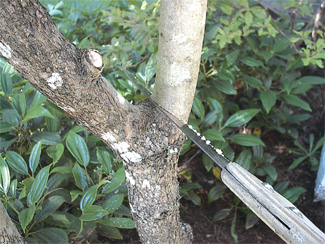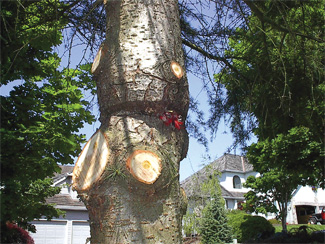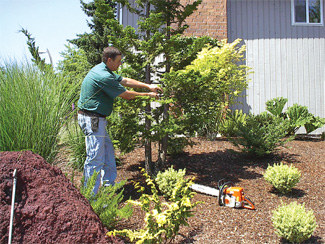
(5)

One big pruning restriction (a rule that you don?EUR??,,????'???t want to bend) involves removing top growth, as with fruit trees and skilled crown reduction. Don?EUR??,,????'???t prune much off the top of trees prior to summer heat?EUR??,,????'???it will open the door to sunburned bark. Save your isolated top-pruning needs for the cool seasons.


Before pruning, always look over the entire tree to locate any potential hazards.
Many trees have multiple leaders, like trunks. Often the leaders form weak ?EUR??,,????'??V?EUR??,,????'?? shaped unions where they join the trunk. These could allow the tree to split.
Trees that lean from a normal vertical position may be slowly progressing into a greater lean over time. Gaps in the soil indicate that the root system is pulling loose as well as detection of changes of the trunk?EUR??,,????'???s angle.
As with major leader unions, branches attached by ?EUR??,,????'??V?EUR??,,????'?? shape unions can be weak.
Inspect trees for peeling bark, hollow cavities and conks or mushroom growth on bark. Fungus is a sign of decay.
Before pruning, investigate the history of the tree. Has the tree been topped? Has the grade changed? Have roots been damaged?EUR??,,????'???possibly from trenching or concrete work? Detected problems may require removing excess fill soil, corrective pruningor possible removal.
Cracks in tree bark can be natural. Usually, cracks in the underlying wood aren?EUR??,,????'???t a good sign. Cracks may be a result of wind and ice damage. Tiny cracks may close over on their own. Large cracks may require that the tree be cabled or removed. Medium cracks may necessitate that the tree be inspected annually or biannually.
Look for broken or hanging branches that are damaged and are hanging by a thread (?EUR??,,????'??hangers?EUR??,,????'??). Be sure to remove these branches?EUR??,,????'???they can fall and injure a trimmer who is not prepared or anyone else that walks or plays beneath the tree.
Deadwood includes any dead branches that are attached properly or improperly that will eventually come loose. These can fall during any season and pose a safety threat.
Sometimes limbs and tree tops break and only fall a few feet before getting caught in the tree. Make sure the leader is intact. If tops or branches have broken loose and are ?EUR??,,????'??hung-up?EUR??,,????'?? in a tree, remove the ones that can be reached. A hard hat is proper gear. If the hazard is too high or you lack the ability and training, contract with a trained arborist for the removal.
Tree bark will engulf wire or rope left on a tree. The trunk above that damage will often become bigger and heavier, but the lower supporting trunk can stay small, slowly starving and getting weaker. If the wire or rope cannot be extracted, the tree may need to be removed.
Trees can conduct electricity. On trees near power lines, look for tree branches with scorched tops?EUR??,,????'???they may have made contact. Trees near power lines require additional training and should not be pruned or moved by anyone other than a qualified person.
Anytime a tree is being pruned?EUR??,,????'???whether by an amateur or a professional?EUR??,,????'???consider it a hazard. Tree workers, even the most safe, don?EUR??,,????'???t always have a clear view of what is below them. Spotters are essential in many tree care operations.
Copyright by M. D. Vaden 2004

According to researchers from the Virginia Cooperative Extension, January and February are the best months to prune alder and crape myrtle trees in their area while beech trees perform best if pruned in July, August and September. Flowering trees like dogwood, crabapple, magnolia and flowering cherry should be pruned in June or July, before flower buds have set. In Washington, the best time to prune forest trees is generally in the fall during their dormant season, but sparks from saws are better arrested in the wet season. So, how do you know when to prune? Many local universities offer tree resources including detailed calendars with recommended pruning months identified by tree type.
University of California?EUR??,,????'???Tree selection, planting, propagation, irrigation, care and diseases ?EUR??,,????'??? www.dnr.wa.gov/htdocs/rp/stewardship/bfs/WESTERN/introduction.html
University of California Cooperative Extension, El Dorado County?EUR??,,????'???Free master gardener classes on pruning, planting and propagation ?EUR??,,????'??? calendar.ucanr.org/calmain.cfm?freshen=yes&group=616
Oregon State University Extension Service?EUR??,,????'???Training and Pruning Your Home Orchard, a 14-page guide that illustrates the basic principles of training and pruning apple, pear, sweet and sour cherries, peach, prune, plum, walnut, filbert and apricot trees.
Order online at or call 800-561-6719. Tree identification ?EUR??,,????'??? oregonstate.edu/trees
Virginia Cooperative Extension?EUR??,,????'???Virginia pruning calendar and tree selection ?EUR??,,????'??? www.ext.vt.edu/pubs/nursery/430-460/430-460.html
Virginia Tech?EUR??,,????'???Tree and woody plant identification ?EUR??,,????'??? www.cnr.vt.edu/dendro
